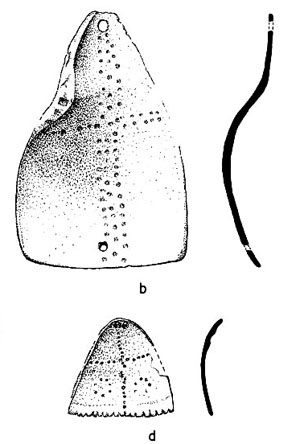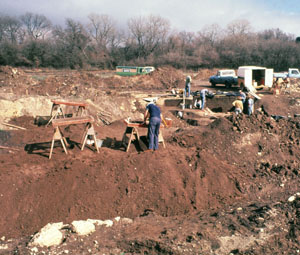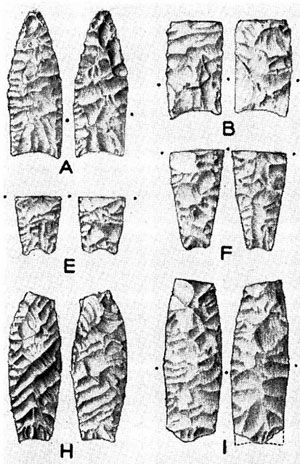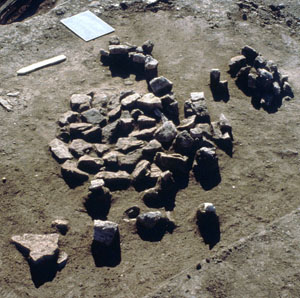Olmos Dam
The Olmos Dam site (41BX1) was a very large occupation site along the west bank of the Olmos Creek in the north-central part of the city of San Antonio. The site lay within the lower part of the Olmos Basin, where several large springs issued forth that were among the uppermost of the San Antonio Springs, the headwaters of the San Antonio River. Today little remains of the site, but the San Antonio Springs/Olmos Basin area was intensively and perhaps almost continuously occupied throughout prehistory from Clovis times onward. As recently as the late 1920s this locale was visited each year by small groups of Ponca Indian elders who made ritual offerings there and collected mescal beans and wild peppers (chili petines) on their way to collect peyote in south Texas. Alas, only a fraction of the site’s human history has been documented.
Over the past two centuries the site and its surroundings have been almost totally transformed into an urban landscape that bears little resemblance to its original setting. In 1849, a newspaper writer called San Antonio Springs “without doubt one of the most beautiful, if not the most beautiful, places in Texas, its woodland grace and park-like beauty so heightened by the perpetual mystery of its profound and noble springs. This is the Head of the River … the Ojo de Agua, the birthright of the city.” Since then the Olmos Creek and the upper San Antonio River have been channelized and dammed, crisscrossed by roads and utility lines, and encroached on by all manner of other urban developments. Through the decades, much of the area has been stripped of its artifacts by collectors and diggers.
The construction of a flood control dam across the Olmos Basin in the mid-1920s gave the archeological site its name and led to its initial documentation by an engineer and artifact collector, C.D. Orchard, a colorful and observant man. Orchard took part in the dam construction project and amassed and documented fascinating artifact collections from sites in the Olmos Basin. It was he who encountered the Ponca Indians there on at least three occasions. Beginning in the 1950s, Orchard collaborated with various archeologists and archeological groups to report some of what he learned and found.
The Olmos Dam “site” was actually a large occupation zone covering well over 100 acres within which discrete burned rock middens were once discernable and across which Orchard and many other collectors picked up untold thousands of artifacts, most of them exposed by erosion, construction, or purposeful artifact digging. Many other artifacts were hauled away as fill dirt. The “site” itself was only one part of a much larger occupation zone. The archeology and early history of the Head of the San Antonio River area is ably summarized in a 1989 report by archeologist Karen Stothert.
The Olmos Dam site clearly represents hundreds and hundreds of occupational episodes that, over time, involved untold thousands of native peoples. The only part of the Olmos Dam site that was properly archeologically documented was a small part of a Late Archaic cemetery that came to light in the late 1970s when Olmos Dam underwent major renovation.
During preparatory bulldozer work, local resident Jack Ferguson spotted a freshly disturbed prehistoric burial and called this to the attention of Dr. Thomas R. Hester at the University of Texas at San Antonio (UTSA). This led to a series of archeological projects by UTSA's Center for Archaeological Research. Initially it was thought that the entire area had been churned up by the original dam project. The presence of intact human remains soon made it clear that part of a Late Archaic cemetery and adjacent occupational deposits had survived.
An archeological crew led by Paul Lukowski spent several months excavating the remnant deposits and documented thirteen burials including four adult men, two adult women, two adults for which gender could not be determined, and five children. It is likely that many more individuals were once interred at the site, but this will likely never be known. The documented burials proved fascinating. In contrast to most prehistoric cemeteries in the region, a large majority of the Olmos Dam burials were accompanied by grave offerings including shell ornaments, bone artifacts, stone artifacts, and large numbers of white-tail deer antler racks. Two associated radiocarbon dates suggest that the cemetery dates to roughly 2,000-2,250 yeas ago.
Putting it all together, the Olmos Dam site was part of what must have been a central place in the lives of many native groups throughout all of prehistory and well into the historic era. It was part of a larger occupation zone where a great many activities far beyond mere “occupation” transpired. While we can never accurately reconstruct even a fraction of what went on there, we know it was an exceptional natural place on the landscape and we can be fairly confident that the following speculative statements ring true about the site’s prehistoric history.
The Olmos dam site and its vicinity at the headwaters of the San Antonio River was a place where people visited for many different purposes and different lengths of time: days, weeks, and months.
On the mundane level that most archeological evidence speaks to, people who visited and stayed here hunted and gathered, built fires, cooked their foods, made tools, and carried countless other ordinary daily-life activities.
On a social level, it was sometimes a gathering place where diverse groups speaking different dialects and languages came together for feasts, special celebrations, courtship, negotiations, and the like.
On a sacred level, it was a place where special rituals took place such as the burial of the dead. From the Late Archaic cemetery that was sampled, the people who were buried here were young and old, male and female and most of them were honored with offerings of what we see today as unusual things which came from afar, required special craftsmanship, and must have had great spiritual and personal meanings to those whose loved ones departed.
All in all, the Olmos Dam site and its vicinity was a place among places in the lives of the prehistoric peoples who lived in the northern South Texas Plains as well as those who lived in the southern Plateaus and Canyonlands, and perhaps some who lived far beyond.
Sources
See Silo, Morhiss Mound, Loma Sandia, and Buckeye Knoll for related cemetery discussions and Mortuary Traditions for an overview.
Lukowski, Paul D.
1988 Archaeological Investigations at 41BX1, Bexar County, Texas. Center for Archaeological Research, University of Texas at San Antonio, Archaeological Survey Report 135.
Orchard, C. D. and T. N. Campbell
1954 Evidences of Early Man from the Vicinity of San Antonio, Texas. Texas Journal of Science 6(4):454-465.
Download PDF![]()
1960 Southwestern Pottery Sites in the Vicinity of San Antonio, Texas. Texas Archeology 4(2):7-8.
Download PDF![]()
Stothert, Karen E.
1989 The Archaeology and Early History of the Head of the San Antonio River. Southern Texas Archaeological Association, Special Publication 5 and Incarnate Word College, Archaeology Series 3.





